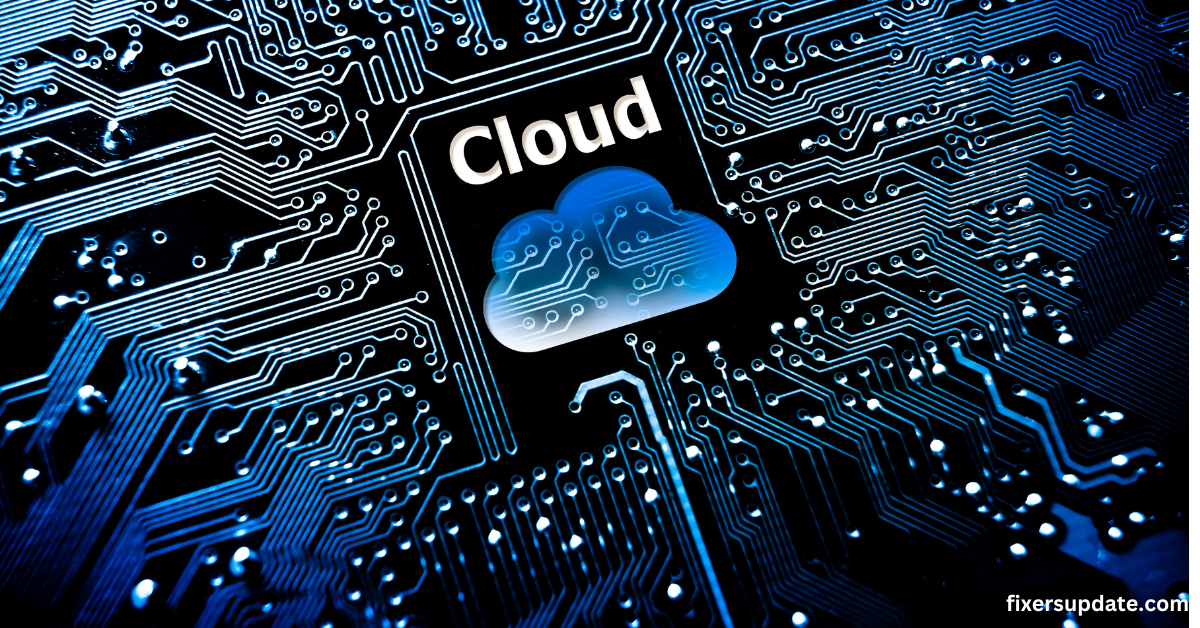In today’s world, the cloud is key for businesses to operate and keep their data safe. As more companies move to the cloud, protecting their data from cyber threats is vital. This guide will share important tips to enhance your cloud security and keep your data safe.
First, we’ll look at the good and bad sides of cloud computing. Then, we’ll talk about how to pick the right cloud service provider. You’ll learn about data encryption, access controls, and how to spot and stop threats.
A surreal digital landscape representing cloud security, featuring a large, stylized cloud with a glowing shield icon embedded within it, surrounded by circuit patterns and glowing locks. The background shows a network of interconnected nodes and data streams, with a high-tech city skyline in the distance, symbolizing protection and connectivity. The overall color palette includes shades of blue, silver, and hints of green to evoke a sense of safety and technology.
We’ll also cover how to follow rules and manage data, the importance of multi-factor authentication, and how to handle vulnerabilities. By the end, you’ll know how to deal with security issues and work well with your cloud service provider.
Keeping your data safe in the cloud is crucial. This guide will give you the tools you need to protect your business from cyber threats. Let’s start this journey and make sure your cloud is secure and safe.
Embracing the Cloud with Confidence
As we start to improve cloud security, it’s key to know the good and bad of cloud computing. The cloud is great for growing, saving money, and being easy to reach. But, it also means more chance of data leaks, following rules, and getting stuck with one provider.
Understanding the Benefits and Risks
Cloud computing has many good points:
- Scalability: You can quickly change how much computing power you use as needs change.
- Cost-efficiency: You only pay for what you use, avoiding big upfront costs.
- Accessibility: People can get to important data and apps from anywhere, helping teams work better together.
But, the cloud also has its own security problems:
- Data breaches: Cloud-stored data can be at risk of being stolen or misused.
- Compliance concerns: Keeping up with rules and data handling standards in the cloud can be hard.
- Vendor lock-in: Relying on one cloud provider can make it hard to switch later.
Evaluating Cloud Service Providers
Choosing a cloud provider needs careful thought to match your security and data handling needs. Important things to look at include:
| Criteria | Importance |
|---|---|
| Security practices and certifications | Check if the provider follows top security standards and has the right certifications. |
| Compliance and data governance | Make sure the provider meets your rules and data handling policies. |
| Incident response and disaster recovery | See if the provider can handle security issues and keep your business running if disaster strikes. |
Knowing the pros and cons of cloud computing and picking a good provider can help you use the cloud safely. This way, you can make the most of cloud benefits while keeping your data and systems secure.
Fortifying Your Data with Encryption
In today’s cloud world, keeping your data safe is key. Encryption is a top way to protect your sensitive info. It makes sure your data stays private, even in the fast-changing cloud.
Data encryption is vital for cloud security. There are two main types: at-rest and in-transit encryption. At-rest encryption keeps your data safe on cloud servers. In-transit encryption protects your info as it moves between devices and the cloud.
Using strong encryption is a must for security and meeting rules. Rules like HIPAA and PCI DSS say you must encrypt sensitive data. Following these rules shows you care about data safety and avoid fines.
But encryption needs good key management to work well. Key management keeps your encrypted data safe. It’s about storing, updating, and controlling your encryption keys to keep your data secure.
| Encryption Type | Description | Benefits |
|---|---|---|
| At-Rest Encryption | Protects data stored on cloud servers | Safeguards sensitive information, meets compliance requirements |
| In-Transit Encryption | Secures data during transmission between devices and the cloud | Prevents eavesdropping and data theft, ensures data integrity |
Encryption is a powerful tool for securing your cloud data. With the right encryption and key management, you can use the cloud safely. You’ll know your sensitive info is protected and follows the rules.
A Proactive Approach to cloud security
Securing your cloud environment needs a proactive plan. A key part of this is using strong access controls. By setting up role-based access controls and following the least privilege principle, you can lower data breach risks. This ensures only approved users can access your sensitive data.
Implementing Access Controls
Effective access controls are vital for cloud security. Start by creating role-based access controls (RBAC) that match your organization’s structure and cloud needs. Give each user or group the right permissions and privileges, so they can do their job without extra access.
Enforcing Least Privilege Principles
- Apply the principle of least privilege, giving users only the needed permissions for their tasks.
- Check and update user access regularly to remove any extra or old permissions.
- Use identity and access management (IAM) tools to manage user identities and access across your cloud.
By focusing on cloud security and access controls, you can protect your cloud environment. This keeps your sensitive data safe from unauthorized access and breaches.
Staying Vigilant: Threat Detection and Monitoring
Effective cloud security needs constant monitoring and quick threat detection. Using security information and event management (SIEM) solutions helps. These tools spot and handle security issues early, protecting your cloud assets. SIEM systems gather, analyze, and link security data from your cloud, giving a full view of your security.
Leveraging Security Information and Event Management
SIEM systems are key in cloud security. They offer several important features:
- They watch and analyze security events, logs, and alerts from different cloud services and apps.
- They connect data from various sources to find and check potential threats, like unauthorized access, odd activity, and data leaks.
- They automatically spot unusual things and security issues, making it easier to quickly look into and fix them.
- They give you a central place to see your cloud security with reports and dashboards.
- They work with incident response plans to make handling security issues smoother.
With a strong SIEM solution, you can stay alert, quickly find threats, and lessen the harm of security breaches in your cloud.
A futuristic control room filled with digital screens displaying cloud security metrics and threat alerts, intricate network maps connected by glowing lines, a central holographic interface illustrating SIEM data analysis, sleek technology and ambient lighting creating a high-tech atmosphere.
Ensuring Compliance and Data Governance
In the world of cloud computing, keeping up with regulations and data governance is key. As a professional copywriting journalist, I’ll help you understand how to align your cloud security with HIPAA, PCI-DSS, and GDPR. We’ll also look at strategies for data governance to protect your cloud-stored information.
Following regulatory rules is crucial for cloud security. Knowing the guidelines helps you protect your data and avoid fines. I’ll show you how to implement access controls and ensure data is stored and sent securely.
Data governance is also vital. It means defining who owns the data, setting policies, and controlling access. By focusing on data governance, you can improve your cloud security, compliance, and data governance.
Aligning with Compliance Frameworks
- Understand the specific requirements of HIPAA, PCI-DSS, GDPR, and other relevant regulations
- Develop and implement policies and procedures to ensure compliance
- Regularly review and update your compliance strategies to stay ahead of evolving regulatory requirements
Implementing Effective Data Governance
- Establish clear data ownership and accountability
- Classify data based on its sensitivity and importance
- Implement access controls and encryption to protect sensitive data governance
- Regularly monitor and audit data access and usage
| Compliance Framework | Key Requirements | Relevant Cloud Security Measures |
|---|---|---|
| HIPAA | Protect the privacy and security of electronic protected health information (ePHI) | Encryption, access controls, audit logging, and breach notification |
| PCI-DSS | Ensure the security of cardholder data | Network segmentation, secure data storage, and regular vulnerability assessments |
| GDPR | Safeguard the personal data of EU citizens | Data minimization, consent management, and data subject rights enforcement |
By understanding compliance and data governance, you can fully benefit from the cloud. It’s important to stay vigilant and compliant. This way, you can use the cloud confidently and protect your data.
Multi-Factor Authentication: Securing Your Fortress
In the world of cloud security, multi-factor authentication (MFA) is a key tool. It adds a layer of protection to your cloud accounts. This makes it hard for hackers to get in, even if they have your login info.
MFA helps fight against the dangers of stolen login details. It ensures only the right people can get into your cloud apps and services. Users must give extra proof, like a code sent to their phone or a biometric scan, to log in.
MFA does more than just protect your cloud space. New ways to log in, like passwordless authentication, are making cloud identity and access management systems safer. These methods ditch old passwords for better, safer options like security keys or face scans.
When you’re building up your cloud security, don’t forget about multi-factor authentication. It turns your cloud into a strong, safe place. This helps keep your digital treasures safe from cloud security dangers.
A digital fortress in the sky, composed of swirling clouds and glowing locks, with intricate circuit patterns running through the cloud formations, symbolizing advanced security. The scene is illuminated by soft blue and green hues, representing technology and safety, with abstract representations of multi-factor authentication elements like keys and shields subtly integrated within the clouds.
Vulnerability Management: Closing the Gaps
In the fast-paced world of cloud computing, keeping your cloud secure is key. Vulnerabilities can be a major weakness. It’s vital to find and fix these issues before hackers can use them.
Patch Management Strategies
Good patch management is at the heart of keeping your cloud safe. Regularly updating your cloud with security patches helps block attacks. A solid patch management plan should include:
- Always check your cloud for new vulnerabilities and patches
- Quickly apply patches to all your cloud systems and apps
- Test patches carefully to avoid problems or downtime
Penetration Testing and Ethical Hacking
Penetration testing and ethical hacking are great for finding hidden weaknesses. They mimic real attacks to spot vulnerabilities. Working with skilled security experts can help you:
- Learn about your cloud’s security strengths and weaknesses
- Focus on fixing the most important vulnerabilities first
- Check if your security measures really work
Using a full approach to vulnerability management, including patching and testing, makes your cloud safer. This reduces the chance of cyber attacks.
| Vulnerability Management Practices | Key Benefits |
|---|---|
| Patch Management | – Closes known security gaps – Mitigates risk of successful attacks – Ensures systems and applications are up-to-date |
| Penetration Testing and Ethical Hacking | – Identifies hidden vulnerabilities – Validates the effectiveness of security controls – Helps prioritize and address critical issues |
Incident Response: Preparing for the Worst
In the world of cloud security, even the best efforts can’t stop all security incidents. That’s why having a strong incident response plan is key. This plan shows how to handle a security breach or other issue. It helps you control the situation, lessen its effects, and get back to normal.
A good incident response plan needs a clear communication strategy. This makes sure everyone, from IT to top leaders, knows what to do. It’s also important to test and update the plan often. The cloud security world changes fast.
- Establish incident response procedures: Clearly define the roles, responsibilities, and escalation protocols to be followed in the event of a security incident.
- Implement incident detection and monitoring: Leverage security information and event management (SIEM) tools to promptly identify and respond to potential threats.
- Develop a plan for incident containment: Outline the steps to be taken to isolate the affected systems and prevent the incident from spreading.
- Prioritize data restoration and recovery: Ensure you have a comprehensive backup and disaster recovery strategy in place to quickly restore your cloud-based systems and data.
- Conduct post-incident reviews: Analyze the root causes and lessons learned from each incident to continuously improve your incident response plan and cloud security posture.
By getting ready for the worst, you can lessen the effects of security incidents. This ensures your cloud operations keep running smoothly. Remember, incident response is an ongoing effort. It needs constant attention, teamwork, and a drive to always get better.
| Key Components of an Effective Incident Response Plan | Benefits |
|---|---|
| Clear communication strategy Defined roles and responsibilities Incident detection and monitoring Containment and recovery procedures Post-incident reviews and improvement | Rapid incident containment and resolution Minimized impact on business operations Restored cloud-based systems and data Continuous improvement of cloud security |
Secure Configurations: The Foundation of Cloud Security
In the fast-paced world of cloud computing, secure settings are key. They help protect your cloud resources from threats. By following best practices, you can lower the risk of data breaches. Also, keeping an eye on your cloud setup is crucial to stay safe from new threats.
Hardening Cloud Resources
Securing your cloud resources is vital. This includes virtual machines, containers, and storage. By adding security controls, you make these resources harder to breach. Here are some ways to strengthen your cloud:
- Use strong access controls and authentication
- Keep cloud services up to date with the latest patches
- Set up network security to block unwanted access
- Use encryption for data safety
- Check and improve cloud settings often
Continuous Monitoring and Auditing
Keeping your cloud safe is a continuous effort. Regular checks and audits are needed to maintain security. This way, you can spot and fix any security issues fast. Audits also help prove you follow important security rules.
Focus on secure settings, harden your cloud, and monitor it closely. This will create a solid cloud security base. It protects your important data and assets in the cloud.
Cloud Service Provider Collaboration
Keeping your cloud secure is a team effort. You and your cloud service provider must work together. It’s important to understand who does what to keep your cloud safe and follow the rules.
Shared Responsibility Model
The shared responsibility model explains who does what in cloud security. It shows where the cloud provider stops and where you start.
- Cloud Service Provider Responsibilities: They handle the basic setup like data centers and networks.
- Customer Responsibilities: You’re in charge of keeping your data and apps safe in the cloud.
Following this model helps make sure your cloud security is top-notch. You’ll manage who can access your cloud, use encryption, and follow the rules.
Working well with your cloud service provider is key. You can create a strong cloud security plan together. This will protect your important data and keep you in line with the law.
Conclusion
Protecting your cloud-based assets and data is key in today’s digital world. By following the tips and strategies in this guide, you can make your cloud environment more secure. This ensures your information stays safe and accessible.
Cloud security is a continuous effort. Stay alert, work with your cloud service provider, and keep improving your security. This way, you can create a strong, cyber-resilient cloud environment. It will help your organization succeed in the digital age.
By focusing on cloud security proactively, you can fully benefit from the cloud. At the same time, you’ll protect your most important assets. Start this journey with a strong commitment to security. Your organization will then enjoy a secure, reliable, and future-proof cloud infrastructure.
FAQ
What are the key aspects of cloud security that I should focus on?
Focus on data encryption, access controls, and threat detection. Also, consider compliance, multi-factor authentication, and vulnerability management. Lastly, don’t forget about incident response. These areas are crucial for cloud security.
How can I ensure my data is protected in the cloud?
Use strong encryption for data at rest and in transit. Make sure to manage your encryption keys well. Also, check your cloud provider’s data governance and compliance to meet your needs.
What is the shared responsibility model, and how does it impact my cloud security?
The shared responsibility model divides security duties between you and your cloud provider. You handle your apps, data, and access. The provider secures the infrastructure and platform. Knowing this model is key to cloud security.
How can I implement robust access controls in my cloud environment?
Use role-based access controls and the least privilege principle. Manage user identities and permissions carefully. This limits unauthorized access and reduces data breach risks.
What are the benefits of implementing multi-factor authentication (MFA) in the cloud?
MFA adds a security layer by requiring extra verification. This includes one-time codes or biometrics, besides usernames and passwords. It helps protect against compromised credentials.
How can I effectively manage vulnerabilities in my cloud environment?
Implement comprehensive vulnerability management. This includes regular patching and penetration testing. It helps find and fix vulnerabilities before they’re exploited.
What steps should I take to prepare for and respond to security incidents in the cloud?
Develop a detailed incident response plan. It should outline steps for breaches or security events. Include containment, impact minimization, and restoration strategies. Regularly test and update your plan to ensure it works.
How can I ensure my cloud configurations remain secure over time?
Harden your cloud resources to reduce attack surfaces. Use continuous monitoring and auditing to spot and fix any security issues. This keeps your configurations secure.














